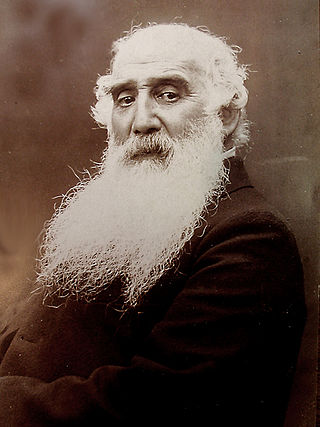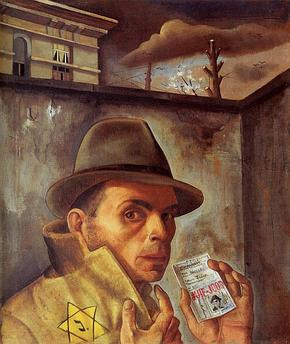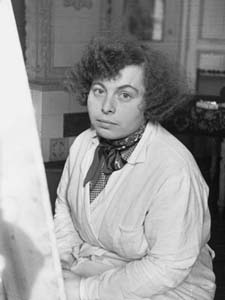
Jacob Abraham Camille Pissarro was a Danish-French Impressionist and Neo-Impressionist painter born on the island of St Thomas. His importance resides in his contributions to both Impressionism and Post-Impressionism. Pissarro studied from great forerunners, including Gustave Courbet and Jean-Baptiste-Camille Corot. He later studied and worked alongside Georges Seurat and Paul Signac when he took on the Neo-Impressionist style at the age of 54.

Lucas Cranach the Elder was a German Renaissance painter and printmaker in woodcut and engraving. He was court painter to the Electors of Saxony for most of his career, and is known for his portraits, both of German princes and those of the leaders of the Protestant Reformation, whose cause he embraced with enthusiasm. He was a close friend of Martin Luther. Cranach also painted religious subjects, first in the Catholic tradition, and later trying to find new ways of conveying Lutheran religious concerns in art. He continued throughout his career to paint nude subjects drawn from mythology and religion.

Franz Moritz Wilhelm Marc was a German painter and printmaker, one of the key figures of German Expressionism. He was a founding member of Der Blaue Reiter, a journal whose name later became synonymous with the circle of artists collaborating in it.

Ernst Ludwig Kirchner was a German expressionist painter and printmaker and one of the founders of the artists group Die Brücke or "The Bridge", a key group leading to the foundation of Expressionism in 20th-century art. He volunteered for army service in the First World War, but soon suffered a breakdown and was discharged. His work was branded as "degenerate" by the Nazis in 1933, and in 1937 more than 600 of his works were sold or destroyed.

Felix Nussbaum was a German-Jewish surrealist painter. Nussbaum's work gives insights into the essence of one person among the victims of the Holocaust.

Adolf Ziegler was a German painter and politician. He was tasked by the Nazi Party to oversee the purging of what the Party described as "degenerate art", by most of the German modern artists. He was Hitler's favourite painter. He was born in Bremen and died in Varnhalt, today Baden-Baden.

The Nazi regime in Germany actively promoted and censored forms of art between 1933 and 1945. Upon becoming dictator in 1933, Adolf Hitler gave his personal artistic preference the force of law to a degree rarely known before. In the case of Germany, the model was to be classical Greek and Roman art, seen by Hitler as an art whose exterior form embodied an inner racial ideal. It was, furthermore, to be comprehensible to the average man. This art was to be both heroic and romantic. The Nazis viewed the culture of the Weimar period with disgust. Their response stemmed partly from conservative aesthetics and partly from their determination to use culture as propaganda.

Karl Christian Ludwig Hofer or Carl Hofer was a German expressionist painter. He was director of the Berlin Academy of Fine Arts.
Euan Ernest Richard Uglow was a British painter. He is best known for his nude and still life paintings, such as German Girl and Skull.

Ludwig Meidner was a German expressionist painter and printmaker born in Bernstadt, Silesia. Meidner is best known for his painted, drawn, and printed portraits and landscapes, but is especially noted for his "apocalyptic" series of work featuring his stylized visions of a pending transformation of Germany before World War I.

Else Meidner was a German-Jewish painter.

Yitzhak Frenkel, also known as Isaac Frenkel or Alexandre Frenel, was an Israeli painter, sculptor and teacher. He was one of the leading Jewish artists of the l’École de Paris and its chief practitioner in Israel, gaining international recognition during his lifetime.
Friedel Dzubas was a German-born American abstract painter.
Oscar Cahén was a Canadian painter and illustrator. Cahén is best known as a member of Painters Eleven, a group of abstract artists active in Toronto from 1953-1960, and for his fifteen years of work as an illustrator for Canadian magazines.
Edward "Ed" Clark was an abstract expressionist painter known for his broad, powerful brushstrokes, radiant colors and large-scale canvases. An African-American, his major contributions to modernist painting remained unrecognized until relatively late in his seven-decade career, during which he pioneered the use of shaped canvases and a commercially available push broom to create striking works of art.
Henry Gowa was a German painter and stage designer.

Georg Muche was a German painter, printmaker, architect, author, and teacher.
Curt Valentin was a German-Jewish art dealer known for handling modern art, particularly sculpture, and works classified as "degenerate", seized from public museums or looted from private collectors by the Nazi regime in Germany.

John Busuttil Leaver is a Maltese visual artist and painter. He has worked in graphic book design and written about contemporary art. He is philosophical about his work and sees what he does as non-commercial: a statement about the contemporary. He is known for his solo show 'A Diary of Obsessions', for work which commented against overdevelopment.
Michael Armitage is a British artist who was born in Kenya. In May 2022, the Royal Mint announced that he would design a new £1 coin for the United Kingdom, to be issued in 2023.












